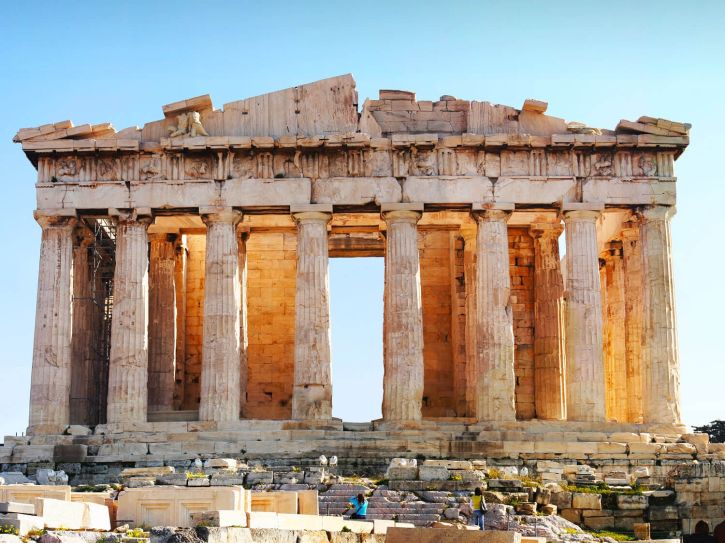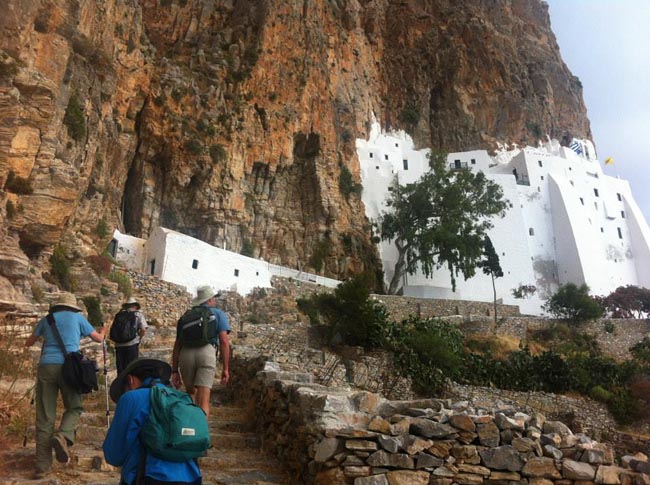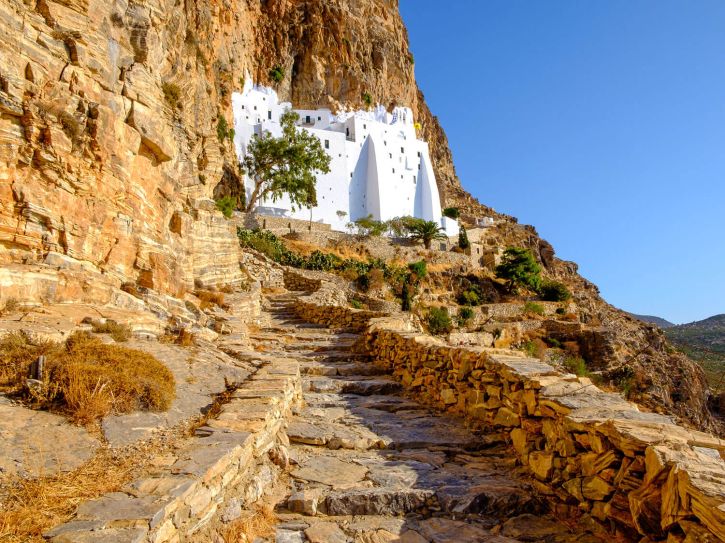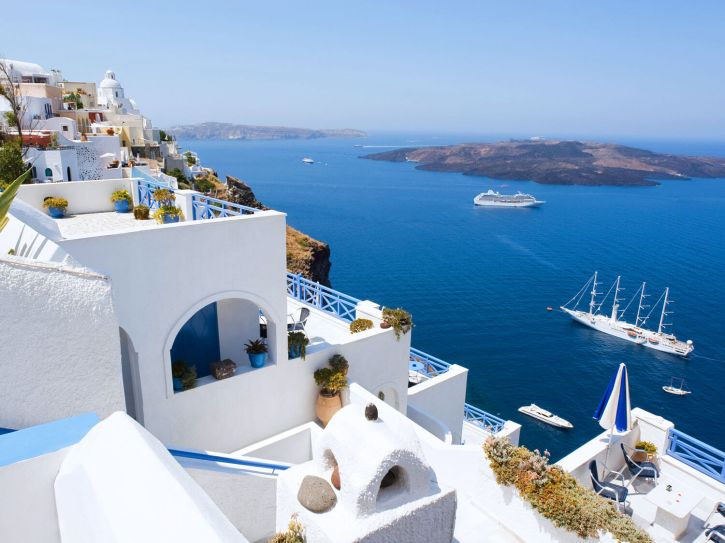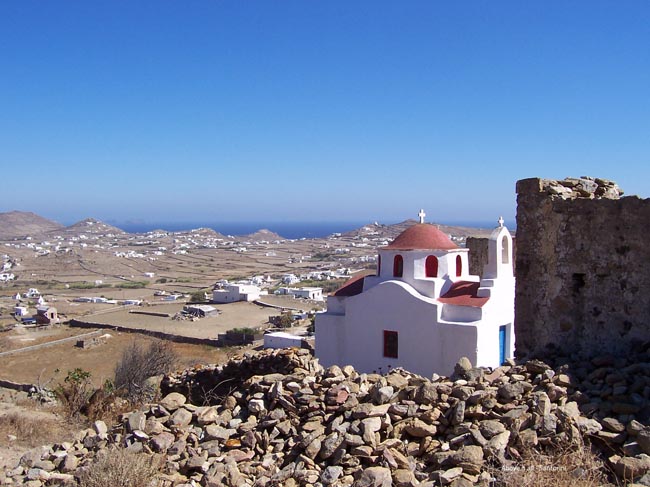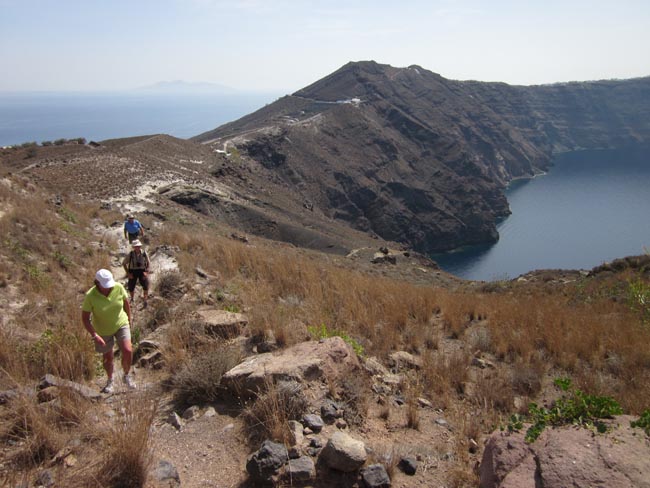Our Hiking the Greek Isles tour begins and end in the iconic capital of Athens, a city steeped in ancient history, and serving as the perfect hub to transport between the idyllic Greek Islands.
Much of Greece is timeless and enduring, and our tour highlights this. From the early days of a walking tour around Athens, we will explore the foundations of a city that began in the 5th century BC with ideas on democracy, philosophy, architecture, and arts that were cultivated and thrived to the point of being exported to the world.
By ferrying to the outer islands,* we leave behind the hustle and bustle of the capital in favour of a serene and picturesque countryside. Scattered churches and pleasant beaches are found across the island of Amorgos, where stunning sunsets cast long shadows across the plentiful olive groves.
Ancient trails are drenched in panoramic views, where valleys and villages emerge beneath rocky hillside vantage points. Ruined windmills rest on craggy ridgelines, while dazzling white monasteries stand above stunning sea cliffs.
From Amorgos we venture to Naxos, a green and fertile island that happens to be the Cyclades largest. Our city tour of Chora will include Venetian inspired architecture, and Byzantine chapels which will clearly demonstrate its long heritage.
While hiking the Greek countryside, we will encounter ancient statues dating back to the 6th century BC, as well as folklore rich villages found dotted along the green hillsides.
Our tour also stops in Santorini, famous for its spellbinding beauty and whitewashed villages found around the ancient caldera. Also known as the island of churches, wine, and donkeys, our strolls along the caldera rim will be full of fascinating stops and scenic vistas.
Our trip ends on Tinos, an important pilgrimage centre for Greek Orthodox members, but beyond the churches are Venetian palaces and stunning views of the blue Aegean Sea.
With a stop in a local taverna, and a chance to taste local homemade cheeses, honey and sausages, our Greek Isles tours comes to an end alongside broad smiles and many miles under our feet.
* The final order of islands may vary depending on season and ferry schedules.
Prices below are per person, twin-sharing costs in US Dollars (USD). Pricing does not include airfare to/from the tour and any applicable taxes. For single supplement rates and taxes (if any), please refer to below Prices & Dates table. For general information on flights to/from the tour, click here.
Your Travel and Accommodation Arranged For You
Tips Included for Driver, Restaurant Staff, Local Guides
Authentic Local Experiences With Lots Of Inclusions.
Select a date below to reserve your spot:
Optional Single Supplement: $840 USD (number of singles limited).
Download Itinerary
Day 1 Arrival in Athens
Today we arrive in Athens, off-and-on the capital of Greece in its many incarnations over several thousand years. Athens pulses with the eclectic, restless--and sometimes chaotic--life of a southeastern European capital. The city’s diverse neighbourhoods are vibrant places with lively squares, shops, galleries, restaurants and cafes, many new and thriving businesses, artistic and theatrical happenings.
Overnight in Athens.
Included Meal(s): Dinner
Day 2 Athens: Walking Tour
The best way to explore a city is on foot, and this is especially true of Athens, which has a number of sites located in close proximity to each other. From our hotel we will enter Plaka, the old town of Athens. Standing on a small square is the Lysicrates Monument, a cyclical tower from the 4th century BC. From here, it is just a brief walk along Dionysiou Areopagitou Street to the southern slope of the Acropolis -- the site of the Dionysos Theatre. Constructed in the 6th century BC, it is one of the world's oldest theatres and the place where the great works of Aeschylus, Sophocles, Euripides and Aristophanes were first performed. Walking down the street towards the entrance of the Acropolis, we will come across a more recent theatre, the Odeon of Herod Atticus from the second century AD, which is still used for concerts and performances.
The highlight of this tour is the ascent to the Acropolis with its architectural masterpieces dating back to the 5th century BC. We reach the top of this hill by entering through the monumental Propylea in order to admire the magnificent Parthenon and the graceful Caryatid statues at the Erechthion Temple.
Turning right at the exit of the Acropolis, we will come to Arios Pagos -- a small hill or a large rock, depending on how you look at it -- which was used as the seat of court during the 5th century BC. This is the place were the Apostle Paul preached to the citizens of Athens 2,000 years ago. The stairs next to the Arios Pagos take us down to the Ancient Agora marketplace. Among the numerous sights in this archaeological park is the well-preserved Temple of Hephaistos and the reconstructed Stoa Attalou. A short stroll away is the more recent Roman Agora from the first century BC and the landmark Tower of the Winds.
The balance of the day is yours to explore independently. Although it is not included on our morning walking tour of central Athens, we recommend a visit to the Acropolis Museum on your own this afternoon, which is located quite close to where we will end our guided walking tour at lunchtime.
Overnight in Athens.
Included Meal(s): Breakfast and Dinner
Not finding what you're looking for?
Our specialists can take away the stress and create a private custom tour tailored to your exact interests and budget.
Day 3 Athens - Ferry to Tinos
Today we travel by ferry to the island of Tinos.* On arrival, we can have a leisurely stroll about Tinos town, taking in the Panagia Church, Greece's most important pilgrimage centre for Orthodox pilgrims. Note the carpeted strip along the main road leading to the church, put in place for pilgrims who demonstrate their piety by crawling the distance from the main waterfront square, up the hill to the church.
According to mythology, Tinos was the home of Aeolus, God of the Winds. The Ionians came to Tinos around 1000 BC; in the 6th century BC Tinos was ruled by Eretria, while in 490 BC the island was seized by the Persians, regaining its freedom after the battle of Marathon. In 1207 Tinos was conquered by the Venetians. Venetian rule in Tinos island lasted longer than on any other island of the Cyclades. In 1715, Tinos was taken by the Turks, to be liberated by the Greeks in the War of Independence of 1821. The year 1822 was an important one for Tinos, for it was then that the famous icon of the Blessed Virgin was discovered, after a nun in the Kechrovouni convent saw it in a dream.
* Due to frequently changing ferry schedules, the actual order of islands visited may vary from this itinerary. If given ample warning, we will update the version specific to your chosen date of departure.
Overnight on Tinos.
Included Meal(s): Breakfast and Dinner
Day 4 Tinos: Volax & Agapi
After breakfast we go by taxi to the village of Falatados where our hiking starts*.
We head uphill to the ruined fortress of Exombourgo to admire a stunning view of the Aegean. Mt Exombourgo is a steep-sided granite cone 553m (1,814 ft) high that features a ruined Venetian castle and the remains of three churches and a fountain-house. This was the medieval capital of the island of Tinos until the town was devastated by the Turks.
We continue to the village of Koumaros where we can make a short break and try a traditional Greek coffee before continuing to the village of Volax, almost hidden in the middle of rounded, granite boulders, a geological phenomenon that sets it apart from the rest of Greece. Volax is also noted for its traditional handmade woven baskets. A footpath winds down the valley to Agapi, the finishing point of today's hike. Look for examples of the island's famous "dovecotes," built long ago for pigeons but today considered works of art. In the old times pigeons were sold to seafarers who came to the island to stock up with supplies.
This evening we have a chance to sample the local cuisine in a typical taverna; Tinos is known for homemade cheeses, honey, and local sausages.
DAY SUMMARY: 3-4 hours leisurely walking over 12-14km/7.5-8.7 mi on undulating, mostly unshaded terrain with uneven cobbled surfaces.
* Our hikes: Our hikes: Because some hikes can/may be adjusted at the discretion of your Tour Leader depending on things like weather and group interest, the final distances/durations of our hikes as indicated in our itinerary should be taken as guidance only. In the meantime, however, we can advise that, generally-speaking, our walks are leisurely on well-trodden pathways over undulating terrain (some walks are downhill), 2-5 hours in overall duration with plenty of breaks for refreshment, photos, and taking it all in.
Overnight on Tinos.
Included Meal(s): Breakfast and Dinner
Day 5 Ferry to Naxos: Chora Walking Tour
This morning we travel by ferry to the island of Naxos, the largest of the Cyclades Islands. Green, fertile, largely self-sufficient Naxos has not needed to go all out to attract tourists. This wealthy agricultural island exports an abundant harvest of olives, grapes, and potatoes throughout the Aegean, and only recently has begun to cater to tourists.
On arrival we will have a walking tour of Naxos Chora, the main town and capital of the island. On our stroll you will note the architecture of Naxos, distinct from that of any other Cycladic isle. The Venetians ruled this island from 1207 until the island fell to the Turks in 1566. Some descendants of the Venetians still live here and the influence of Venetian architecture is obvious in the Kastro and the fortified Venetian towers. Also specific to Naxos is the remarkable abundance of small Byzantine chapels, many of which contain exceptional frescoes dating from the 9th to the 13th centuries.
Our walk ends at the Portara, the big marble gate that stands high on the island of "Bacchus" and is the remains of the ancient temple of Apollo. The ruins of the temple are called "Palace" implying the palaces of Ligdami the ancient tyrant of Naxos (6th century BC). The legend says that Theseus abandoned Ariadne there when he passed through Naxos after he slew the mythical minotaur on Crete.
While in town you should purchase picnic items for tomorrow's hike, though we should be able to acquire refreshments in the villages we visit.
Overnight on Naxos.
Included Meal(s): Breakfast and Dinner
Day 6 Naxos: The Kouroi & Potamia
Today's hike not only combines a few highlights of the island, such as the kouroi (ancient statues) and the green valley of Potamia.
We begin with a taxi ride to Melanes from where a narrow and nicely paved trail leads to the Kouros of Melanes, or Flerio. This statue dates from the 1st half of the 6th century BC and it was never finished because of a crack in the material. Through a little gate on the left we can get to the gardens of the Kondili-family; the land where the statue is situated actually belongs to this family.
Next we encounter the Kouros of Potamia, amidst the remnants of an old stone quarry. Local farmers offer some explanations on the statue and tell us that we are actually dealing with a "kore", the statue of a girl.
You get a beautiful view on the site of Agios Mamas and after a couple of minutes we'll take a left into the valley. This road describes a couple of bends and thus meanders to the church of Kato Potamia. In front of the church you find a truly beautiful front yard with a large eucalyptus tree.
From here we can take the local bus back to Chora (if our timing is right) or reconnect with our taxis.
DAY SUMMARY: Altogether this makes 2h 50 minutes of actual walking time; taking into account all of the breaks and a picnic, we expect to hike for about 5 hours over 8-10km/5-6 mi.
Overnight on Naxos.
Included Meal(s): Breakfast and Dinner
Day 7 Naxos: Apiranthos - Fanari - Chalki
We begin the day by driving up into the mountains where we will set out on our first hike today at the village of Apiranthos in its main square. We ascend by foot for about an hour on a narrow mountain footpath from the top of the village to the peak of Mount Fanari and the little church of the Panagia Fanariou located there. From here we have expansive views towards Mount Zas, the island’s highest peak, as well as down into the valley of Tragea, where we will be hiking later on today. From Mount Fanari, we return on foot to Apiranthos for a lunch break in the main pedestrian square.
After lunch, our bus takes us to the village of Moni, where we stop at the ancient church of the Panagia Drosiani, the Virgin of Cool Breezes. We begin our second hike of the day from here. It takes us on an undulating, often shady, path through olive groves where there are numerous trees with trunks of impressive girth, which are hundreds of years old. Approximately an hour and a half after we begin this route, we arrive at the village of Chalki, at the bottom of the valley.
Undulating terrain and cobbled can be expect today. There will be some shade but, as is typical of the isles, large trees are few and far between. Exact distances and timing are difficult to guess today; as your Tour Leader will know by now your abilities, please consult with him/her if you are concerned about your suitability for today's activity.
Overnight on Naxos.
Included Meal(s): Breakfast and Dinner
Day 8 Naxos - Ferry to Amorgos
Today we ferry to the island of Amorgos.
Amorgos's timeless monastery, scattered churches, and pleasant beaches offer both respite from tourists on the other islands and a taste of traditional Greece. For many, Amorgos has become the highlight of the tour, accurately described as "the soul of Greece." The locals are extremely friendly, the mountains surrounding the port majestic, and the sunsets stunning. It has been the location of several movies and is a super place for walks through idyllic olive groves.
Overnight on Amorgos.
Included Meal(s): Breakfast and Dinner
Day 9 Amorgos: Tholaria & Langada
This hike is one of the most beautiful on Amorgos. The whole route involves magnificent ancient trails through the paleis above Aegiali. The panoramic views and the villages make this day an unforgettable experience. Aegiali is an area consisting of three traditional villages: Langada, Tholaria, and Potamos, which sit on the slope of the highest mountain on Amorgos, Krikellos (821m/2,709 ft). They are built above a deep valley and the harbour of Aegiali where a beautiful sandy beach spans the gentle curve of the bay.
We begin this morning’s hike at the mountain village of Tholaria. Our way is a cobbled donkey path that connected the surrounding villages before there were any paved roads in the area. This first stretch is a traverse that affords spectacular views of the steep slopes and wide well-watered valley of Aegiali, spreading to the sweeping sandy bay beneath Mount Krikellos, the island’s highest peak at 823 metres (2,716 feet). Our route takes us to the gorge of
Araklos, and the nearby church of the Panagia Epanohoriani, the area’s most important place of worship and annual festival.
From here we descend towards the white village of Langada, passing the half-ruined settlement of Stroumbos, where in recent years foreigners have restored several of the old stone houses. This village has no road and no electricity. In Langada, we pause for refreshment at a local cafe, exploring the pretty village streets along the way.
Descending from Langada towards the coast, we make a brief ascent to the tiny cliff-side church of Agia Triada, once a stronghold to which to retreat when pirates threatened. Our morning’s hike ends at the water-side settlement of Aegiali, where there are several good restaurants for lunch. (We suggest packing a bathing suit and towel today, so as to be able to enjoy a swim after lunch at the long curving stretch of sandy beach nearby.) After a break by the water, there is a choice to return to our hotel in the village of Tholaria either by foot or by local bus.
This evening (or possibility another time at the discretion of your Tour Leader) we enjoy a Greek cooking class, with emphasis on traditional, family-style island dishes.
DAY SUMMARY: The hike takes a little over four hours (real walking time - walking distance +/- 6.5 kms/4 miles). Terrain is undulating with loose stones and cobbled surfaces. While we make efforts to accurately estimate empirical distances in kilometres and miles, accurate measure is difficult, and this statistic might not mean as much as the variations in route incline/decline, quality, and directness.
Overnight on Amorgos.
Included Meal(s): Breakfast and Dinner
Day 10 Amorgos: Chora & Chozoviotissa Monastery (to Aegiali)
Early this morning we travel by road to Chora, the capital of the island. We will pause here to stroll about the village, set high above the sea protected from pirates of bygone days. We leave the village and follow a magnificent staircase going down to the Monastery of Chozoviotissa.* The monastery is home to the revered icon of the Virgin from the Holy Land. The dazzling white building, founded in the year AD 1099, clings precariously to a cliff face. The icon was found in the sea below the monastery, having arrived here unaided from either Asia Minor, Cyprus or Jerusalem. We will enter the monastery and climb into its snug interior. Hopefully the docent will be available to show us around and provide access to the tiny but fascinating museum.
After our visit to the monastery, we commence our hike.** This is definitely one of the most fabulous hikes in the Cyclades, and the longest and most difficult of our trip. We follow the spine of the island and discover some unique landscapes and flora and, of course, some stupendous views. Leaving the monastery, we climb a staircase into an impressive landscape; the silence is overwhelming. High above us towers a huge cliff and on the right you see the deep blue sea below. Twenty minutes after the monastery we get to a platform with remnants of stable walls -- behind you, the highest top of the monastery is just disappearing.
We continue through impressive and rocky wilderness; soon we reach a kind of saddle with the two coasts of Amorgos both before and behind us. Soon we come to the Xenodochio, the remnants of a kind of medieval hotel on the road from Chora to Aegiali. Gradually we get a great view on the elongated offshore islet of Nikouria. At Exo Meria, situated on a rocky plateau, we find some deserted houses and the ruins of two windmills. It is hard to imagine how difficult and lonely life must have been on this desolate spot.
The trail now continues like a magnificent balcony: far away you can already distinguish the village of Tholaria and all of a sudden you get a great view on the bay of Aegiali where our hike ends at a lovely beach where you can cool off and relax until dinner.
DAY SUMMARY: Approx 4-5 hours (actual walking, longer with stops) over 17.5km/11 mi on uneven, undulating terrain. The path is quite well worn at first, though in places the route becomes quite vague. Expect loose stones and gravel. There is no shade along the route and one can expect a chill wind, especially in the spring (thought the stupendous wildflowers make up for this!).
* PLEASE note that our visit comes with a dress code. Women must wear a long loose-fitting skirt, or sarong -- something light and wrap-around is easiest -- over your shorts or long pants for our visit. Men should wear long pants (light hiking pants are fine); we suggest that you bring a pair of shorts as well so you can change into them should weather conditions allow.
** Some travellers choose to visit Chora and the monastery ONLY and forgo today's hike, the longest on the tour. Please confer with your Tour Leader who, by this point, will have a good sense of your suitability for today's plans.
Overnight in Amorgos.
Included Meal(s): Breakfast and Dinner
Day 11 Amorgos - Ferry to Santorini
Today we ferry to the island of Santorini, also known as Thira.
Vast geological upheavals have given this island its unique form resulting in the nickname, "Pre-Historic Pompeii." The effect of terracing makes this unlike any other island, Greece's most visually stunning. Santorini is also the island of churches, wine, and donkeys! From as early as 3000 BC the island developed as an outpost of Minoan civilization until around 1500 BC when the volcano erupted. At this point the island's history became linked with the legend of Atlantis.
This afternoon (ferry timing permitting), you may be interested to do a hike to the site of Ancient Thira, located 400m / 1,320 ft above the beach on the southeast coast of the island. Here we find the ruins of an 11th century BC Dorian settlement excavated by a German expedition in the 1860s. Here we can see remains from the Hellenistic, Roman, and Byzantine periods. The ruins are limited, but you can see evidence of temples, houses with mosaic floors, an agora, gymnasium, and a theatre with stunning and sheer views to the sea. Alternatively you can stay behind and enjoy one of Santorini's finest black sand beaches.
DAY SUMMARY: 1.5 hours round trip, paved surface (switchback road).
Overnight on Santorini.
Included Meal(s): Breakfast and Dinner
Day 12 Santorini: Akrotiri & the Caldera Rim to Oia
This morning we visit the site of Akrotiri, where excavations have revealed a complete prehistoric Minoan city with squares, streets and two-storey houses which contained marvellous frescoes. The buildings date to the late 16th century BC. No skeletons or treasures have been found in Akrotiri, so historians think that the inhabitants were forewarned of the eruption and were able to escape. The excavations have yielded evidence what has revolutionized our knowledge of the Late Bronze Age; indeed the town has been called a "bronze-age Pompeii."
We then travel by bus to Fira, the main town on Santorini. Our 3.5 hour hike takes us through the town's narrow walkways northward through the sister villages of Fira -- Firostefani and Imerovigli -- along the caldera rim to Oia ("Ee-ah") via a truly magnificent route. This is the most obvious hike on Santorini and offers many changing views of the deep blue sea, distant snow-white villages, and multi-hued caldera cliffs. Built on a steep slope of the caldera, many of Oia's dwellings nestle in the niches hewn in the volcanic rock. It was once a major fishing port but is principally known these days as probably the most dramatically situated town in the whole of Greece.
Overnight on Santorini.
Included Meal(s): Breakfast and Dinner
Day 13 Santorini - Fly to Athens
Today we'll fly back to Athens, aiming to have some free time in the city for some last minute shopping and/or sightseeing and our farewell dinner.
PLEASE NOTE: Ever-changing air schedules and weather delays may necessitate a return to Athens by ferry.
Overnight in Athens.
Included Meal(s): Breakfast and Dinner
Day 14 Departure from Athens
Departure from Athens.
KALO TAXIDI!!
Included Meal(s): Breakfast
Inclusions
Breakfast and dinner (hotels & local restaurants) daily. All accommodation, transport, sightseeing and entrance fees for sites noted as 'visited' in the detailed itinerary. Gratuities for restaurant staff, porters (if available). Airport transfers for land & air customers arriving/departing on tour dates.
Exclusions
International airfare to/from the tour. Tour Leader gratuities, lunches, drinks, personal items (phone, laundry, etc), international air taxes (if applicable), any excursions referenced as 'optional'. Airport transfers for Land Only customers. Optional trip cancellation insurance and single supplements fees. Our post-reservation trip notes offer further guidance on optional meal costs and shopping.
Seasonality and Weather
Our spring date is planned to avoid the busier and expensive high summer high season (July/August) during which ferries can be crammed and some sites can be overcrowded (especially in Athens). Our timing also avoids the extreme summer heat and high winds winds often associated with this time. Greece does not experience the extreme humidity of the tropics so this is not a concern at any time.
May/June is a gorgeous time in terms of the landscape, which after winter rains is lush and green and festooned with wildflowers. The sea is swim-able but still a bit chilly, and showers, though unlikely, are still possible. Another nice thing about springtime in Greece is the local people are well-rested after a long winter and especially delighted to see us!
Late summer (September) is generally warmer and one can still expect some heat, especially in Athens and elsewhere depending on proximity to water. Showers are less likely than spring. Though the landscape has largely shed the lush greenness of spring, the true delight is the local farm produce ready for harvest at this time, all of which makes it's way into local dishes. It's also the time of the olive and grape harvest, which we may be able to witness.
Transport and Travel Conditions
Local ferries between mainland/islands can range from hydrofoils to large vehicular vessels--all bookings in economy class. Greek ferry schedules tend to change without notice; some itinerary adjustments may be necessary at the discretion of your Tour Leader.
Land transport (island touring, port transfers) by private bus, public bus, and taxi.
OUR HIKES
Generally-speaking, our walks are leisurely on well-trodden pathways over undulating terrain (some walks are downhill), 2-5 hours in overall duration with plenty of breaks for refreshment, photos, and taking it all in. Please note that some surfaces feature loose material (ie stones, gravel, sand etc) which can be slippery. Good footwear/tread and walking poles will help to steady you and support your knees.
Our difficulty rating "Level 3" refers to our walks/hikes that go beyond town/city walking tours on pavement or cobblestones, to hiking on "natural" surfaces (ie gravel) and pathways that feature some elevation gain/loss as opposed to mostly flat terrain. Such hikes are leisurely with plenty of stops along the way, but they can be of a greater duration than our cultural tours that under category #2. We also rate this as a #3 due to the nature of some trails, whose surfaces can be very undulating and uneven with loose rocks and gravel.
While hiking activity does not occur every day, even when not on a "hike," we will be on foot quite a lot with town walking tours, site visits, and plenty of places with uneven surfaces and stairs. Participants should be fit and active and accustomed to trail walking, possibly in some remote locations, and be prepared to engage in a conditioning regimen prior to the trip. Because some hikes can/may be adjusted at the discretion of your Tour Leader depending on things like weather and group interest, the final distances/durations of our hikes as indicated in our itinerary should be taken as guidance only.
This is a hotel-based tour with no camping, and you are required to only carry what you need for the day.
For daily summary of our hiking activities, please refer to the tour itinerary.
Am I suitable for this tour? Please refer to our self-assessment form.
Activity Level: 3
These tours are considerably more strenuous than our Level 1 & 2 "cultural" tours and feature walks/hikes on undulating and uneven pathways for 3-7 hours at a leisurely pace. We don't hike every day, but participants should be fit and active and accustomed to trail walking, possibly in remote locations, and be prepared to engage in a conditioning regimen prior to the trip. Altitude may also be a factor on some tours, though none of our hiking tours currently occur above 3000m/10,000 ft. These are hotel-based tours with no camping, and you are required to only carry what you need for the day.
To learn more about the Activity levels, please visit our tour styles page.
Accommodation
Well-located, air-conditioned, mid-range hotels (3-star) throughout. Island hotels are smaller properties (3-4 story) that will likely not have elevators. All hotels have en suite bath, though most have shower only. A special note about Santorini, which is primarily a luxury tourism destination and, while we can confidently promise our visit will be fulfilling and rewarding, one's hotel expectations must be in line with our overall purpose, which is sightseeing and cultural experience and not focused on the "hotel experience" per se.
Porter service is rarely available on the islands (see 'inclusions'); you MUST be independent with your luggage, especially getting on / off ferries. Single rooms are limited and likely smaller than twins. Many hotels have swimming pools and / or beach access.
Staff and Support
Tour Leader, local guides at some locales.
Group Size
Maximum 16 plus Tour Leader
Regions visited: Western Europe
Countries visited: Greece
*The red tour trail on the map does not represent the actual travel path.
The following is a list of sample hotels at some locations included on this tour. The hotels shown here are meant to provide a general sense of the standard of hotel we usually aim for; they are not necessarily confirmed for your chosen departure.












Naxos Palace Hotel has been developed on a hillside in an amphitheatric way, allowing most of the rooms a panoramic sea view. One of the best hotels in Naxos, Naxos Palace is a guarantee for a wonderful accommodation!







The hotel is located in Firostefani village just 10 minutes walk from the capital of Santorini, the village of Fira. Santorini Palace combines the Cycladic surroundings with the breathtaking views of the east side of the island.
Nearby Attractions are The Dominican Convent, The Catholic Cathedral, The Greek Orthodox Cathedral, The cable car and the old port, The Archeological Museum, the Prehistoric Museum, shops, restaurants and nightclubs.
Tourcode: XGI
